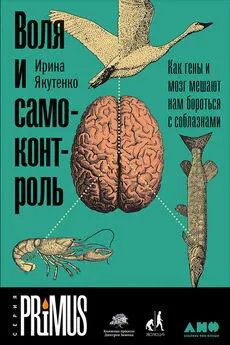Рейчел Херц - Почему мы едим то, что едим [Наука о том, как наш мозг диктует нам, что есть]
- Название:Почему мы едим то, что едим [Наука о том, как наш мозг диктует нам, что есть]
- Автор:
- Жанр:
- Издательство:Литагент 5 редакция
- Год:2021
- Город:Москва
- ISBN:978-5-04-097490-0
- Рейтинг:
- Избранное:Добавить в избранное
-
Отзывы:
-
Ваша оценка:
Рейчел Херц - Почему мы едим то, что едим [Наука о том, как наш мозг диктует нам, что есть] краткое содержание
Какие музыкальные жанры лучше всего подчеркивают вкус красного вина? Почему нам хочется калорийной пищи, когда нас постигают неудачи? Как наша личность соотносится с предпочтением сладкого или соленого?
Эта книга, словно чуткий проводник, помогает читателю уловить и распознать сенсорные, психологические и физиологические факторы, лежащие в основе пищевых привычек. С этим знанием вы сможете сделать каждый прием пищи осознанным и здоровым, а также получать только удовольствие от еды.
Почему мы едим то, что едим [Наука о том, как наш мозг диктует нам, что есть] - читать онлайн бесплатно ознакомительный отрывок
Интервал:
Закладка:
ПРИМЕЧАНИЯ К СТР. 35–39
46. J. E. Mangold et al., «Bitter taste receptor gene polymorphisms are an important factor in the development of nicotine dependence in African Americans», Journal of Medical Genetics 45 (2008): 578–582.
47. M. D. Basson et al., «Association between 6-n-propylthiouracil (PROP) bitterness and colonic neoplasms», Digestive Diseases and Sciences 50 (2005): 483–489.
48. A. Milunicova et al., «Hereditary blood and serum types, PTC test and level of the fifth fraction of serum lactatedehydrogenase in females with gynecological cancer (II. Communication)», Neoplasma 16 (1969): 311–316.
49. S. T. DiCarlo and A. S. Powers, «Propylthiouracil tasting as a possible genetic association marker for two types of alcoholism», Physiology and Behavior 64 (1998): 147–152; V. B. Duffy, J. M. Peterson and L. M. Bartoshuk, «Associations between taste genetics, oral sensation and alcohol intake», Physiology and Behavior 82 (2004): 435–445.
50. B. G. Oberlin et al., «Beer flavor provokes striatal dopamine release in male drinkers: Mediation by family history of alcoholism», Neuropsychopharmacology 38 (2013): 1617–1624.
51. M. Macht and J. Mueller, «Increased negative emotional responses in PROP supertasters», Physiology and Behavior 90 (2007): 466–472.
52. R. S. Herz, «PROP taste sensitivity is related to visceral but not moral disgust», Chemosensory Perception 4 (2011): 72–79.
53. C. Sagioglou and T. Greitemeyer, «Individual differences in bitter taste preferences are associated with antisocial personality traits», Appetite 96 (2015): 299–308.
54. K. J. Eskine, N. A. Kacinik, and J. J. Prinz, «A bad taste in the mouth: Gustatory disgust influences moral judgment», Psychological Science 22 (2011): 295–299.
55. R. S. Ritter and J. L. Preston, «Gross gods and icky atheism: Disgust responses to rejected religious beliefs», Journal of Experimental Social Psychology 47 (2011): 1225–1230.
56. K. J. Eskine, N. A. Kacinik, and G. D. Webster, «The bitter truth about morality: Virtue, not vice, makes a bland beverage taste nice», PLoS ONE 7 (2012): e41159.
ПРИМЕЧАНИЯ К СТР. 39–49
57. V. Erden et al., «Relation between bitter taste sensitivity and incidence or intensity of propofol injection pain», European Journal of Anaesthesiology 24 (2007): 516–520.
58. N. Kolble et al., «Gustatory and olfactory function in the first trimester of pregnancy», European Journal of Obstetrics and Gynecology and Reproductive Biology 99 (2001): 179–183.
59. M. A. Carskadon et al., «Circadian influences on smell and taste detection thresholds: Preliminary results from adolescents», Sleep 38 (2015): A67.
60. «Immune System Protein Regulates Sensitivity to Bitter Taste», Monell Center, April 21, 2015, http://www.monell.org/news/ news_releases/ TNF_bitter_taste.
61. P. Feng et al., «Regulation of bitter taste responses by tumor necrosis factor», Brain, Behavior, and Immunity 49 (October 2015): 32–42.
62. Jill U. Adams, «Taste Receptors in the Nose Help Fight Infections», Scientific American, August 19, 2014, http://www.scientificamer-ican.com/article/taste-receptors-in-the-nose-help-fight-infections.
1. «The Taste of Electric Currents», Improbable Research, http:// www.improbable.com/2014/01/15/the-taste-of-electric-cur-rents-part-1-of-2; «Johann Georg Sulzer», Wikipedia, https:// en.wikipedia.org/wiki/Johann_Georg_Sulzer.
2. См. L. M. Bartoshuk, «Taste», in J. E. Wolfe et al., eds., Sensation and Perception (Sunderland, MA: Sinauer Associates, 2014).
3. J. Prescott, «Effects of added glutamate on liking for novel food flavors», Appetite 42 (2004): 143–150.
4. Harold McGee, «On MSG and Chinese Restaurant Syndrome»,
Lucky Peach, Summer 2011, http://luckypeach.com/
on-msg-and-chinese-restaurant-syndrome.
5. N. Shigemura et al., «Genetic and molecular basis of individual differences in human umami taste perception», PLoS ONE 4 (2009): e6717– e6717.
6. David Nield, «Scientists Have Discovered a New Taste, and It Could Help Us Treat Obesity», Science Alert, July 21, 2015, http://www.sciencealert.com/scientists-have-discovered-a-new-taste-and-it-could-help-us-treat-obesity.
ПРИМЕЧАНИЯ К СТР. 50–57
7. «FDA Approves Fat Substitute, Olestra», U.S. Department of Health and Human Services, https://archive.hhs.gov/news/ press/1996pres/960124a.html; «Olestra», Wikipedia, https:// en.wikipedia.org/wiki/Olestra.
8. «Essential Fatty Acids», Physicians Committee for Responsible Medicine website, http://www.pcrm.org/health/health-topics/ essential-fatty-acids.
9. C. A. Running, B. A. Cr^^ijg, and R. D. Mattes, «Oleogustus: The unique taste of fat», Chemical Senses, published online (опубликовано онлайн) July 3, 2015; M. Y. IPqoiiH'o et ah. «The faUy acid translocase gene CD36 and lingual lipase influence oral sensitivity to faa fn obese subjects», Journal of Lipid Research 53 (2012): 561–566.
10. P. Platte et al., «Oral perceptions of fat and taste stimuli are modulated by affect and mood induction», PLoS ONE 8 (2013): e65006.
11. B. V. Howard et al., «Low-fat dietary pattern and risk of cardiovascular disease: The Women’s Health Initiative Randomized Controlled Dietary Modification Trial», Journal of the American Medical Association 295 (2006): 655–666.
12. S.K. Venn-Watson, «Increased dietary intake of saturated fatty acid heptadecanoic acid (c17:0) associated with decreasing ferritin and alleviated metabolic syndrome in dolphins», PLoS ONE 10 (2015): e0132117.
13. Kat Gilmore, «Study finds high-fat diet changes gut microflora, signals to brain», UGA Today, July 7, 2015, http://news.uga. edu/releases/articlehigh-fat-diet-changes-gut-microflora-sig-nals-to-brain-0715.
14. M. G. Tordoff, «The case for a calcium appetite in humans», in C. M. Weaver and R. P. Heaney, eds., Calcium in Human Health (New York: Humana Press, 2006), 247–266.
15. Charles Q. Choi, «Sixth ‘Taste’ Discovered – Calcium», Live Science, August 20, 2008, http://www.livescience. com/5059-sixth-taste-discovered-calcium.html.
16. «Eating Clay: Lessons on Medicine from Worldwide Cultures», Enviromedica, http://www.magneticclay.com/eating-clay.php.
17. Linda Chen, «The Old and Mysterious Practice of Eating Dirt, Revealed», The Salt, NPR, April 2, 2014, http://www. npr.org/sections/thesalt/2014/04/02/297881388/the-old-and-mysterious-practice-of-eating-dirt-revealed.
ПРИМЕЧАНИЯ К СТР. 58–69
18. M.G. Tordoff et al., «T1R3: A human calcium taste receptor», Scientific Reports 2: 496 (2012).
19. «14 Non-Dairy Foods That Are High in Calcium», Health, http:// www.health.com/health/gallery/0,20845429_3,00.html.
20. Для справки см. M. G. Tordoff, «The case for a calcium appetite in humans», in Weaver and Heaney, eds., Calcium in Human Health.
21. Точный масштаб: 215 000 квадратных футов.
22. McIlhenny Company, Tabasco Sauce website, http:// www.tabasco.com/mcilhenny-company/faqs-archives/ #how-hot-is-each-flavor.
23. «Bhut jolokia», Wikipedia, http://en.wikipedia.org/wiki/ Bhut_Jolokia.
24. «Hottest chili», Guinness World Records, http://www.guinness
worldrecords.com/world-records/hottest-chili; «Top 10 Hottest Peppers», Pepperhead, https://www.crazyhotseeds.com/
top-10-worlds-hottest-peppers.
25. I. Borbiro, D. Badheka, and T. Rohacs, «Activation of TRPV1 channels inhibits mechanosensitive Piezo channel activity by depleting membrane phosphoinositides», Science Signaling 8 (2015): ra15.
26. M. Chopan and B. Littenberg, «The association of hot red chili pepper consumption and mortality: A large population-based cohort study», PLoS ONE 12 (2017): e0169876.
27. N. K. Byrnes and J. E. Hayes, «Personality factors predict spicy food liking and intake», Food Quality and Preference 28 (2013): 213–221.
28. N. K. Byrnes and J. E. Hayes, «Gender differences in the influence of personality traits on spicy food liking and intake», Food Quality and Preference 42 (2015): 12–19.
29. L. Begue et al., «Some like it hot: Testosterone predicts laboratory eating behavior of spicy food», Physiology and Behavior 139 (2015): 375–377.
1. В целях сохранения анонимности я изменила имя истца и некоторые детали.
2. A. Wrzesniewski, C. McCauley, and P. Rozin, «Odor and affect: Individual differences in the impact of odor on liking for places, things and people», Chemical Senses 24 (1999): 713–721.
ПРИМЕЧАНИЯ К СТР. 69–76
3. Guides to the Evaluation of Permanent Impairment 6th Edition (2008). American Medical Association.
4. Личное общение, Dr. Steven Van Toller, July 28, 2010.
5. R. W. Wrangham, Catching Fire: How Cooking Made us Human (New York: Basic Books, 2009).
6. Нейрогастрономия – это синтез кулинарных, биохимических и нейропсихологических факторов, влияющих на восприятие пищи.
7. R. Ni et al., «Optimal directional volatile transport in retronasal olfaction», Proceedings of the National Academy of Sciences 112 (2015): 14700-14704; Angus Chen, «Mechanics Of Eating: Why You’ll Miss Flavor If You Scarf Your Food», The Salt, NPR, November 10, 2015, http://www.npr.org/sections/thesalt/2015/11/10/455475805/ mechanics-of-eating-why-youll-miss-flavor-if-you-scarf-your-food.
8. Ryn Gargulinski, «Top 5 Causes of Accidental Death in the United States», Listosaur.com, July 22, 2011, http://listosaur.com/miscel-laneous/top-5-causes-of-accidental-death-in-the-united-states.
9. Herz, R. (January 21, 2008). Buying by the Nose. ADWEEK. http://www.adweek.com/brand-marketing/buying-nose-94779.
10. I. Fedoroff, J. Polivy, and C. P. Herman, «The specificity of restrained versus unrestrained eaters’ responses to food cues: General desire to eat, or craving for the cued food?» Appetite 41 (2003): 7-13.
11. M. R. Yeomans, «Olfactory influences on appetite and satiety in humans», Physiology and Behavior 87 (2006): 800–804.
12. S. Chambaron et al., «Impact of olfactory and auditory priming on the attraction to foods with high energy density», Appetite 95 (2015): 74–80.
13. M. Gaillet-Torrent et al., «Impact of a non-attentively perceived odour on subsequent food choices», Appetite 76 (2014): 17–22.
14. C. P. Herman and J. Polivy, «The Self-Regulation of Eating: Theoretical and Practical Problems», in R. F. Baumeister and K. D. Vohs, eds., Handbook of Self-Regulation (New York: Guilford, 2004), 492–508; K. E. Demos, W. M. Kelley, and T. F. Heatherton, «Dietary restraint violations influence reward responses in nucleus accumbens and amygdale», Journal of Cognitive Neuroscience 23 (2011): 1952–1963.
Читать дальшеИнтервал:
Закладка:
![Обложка книги Рейчел Херц - Почему мы едим то, что едим [Наука о том, как наш мозг диктует нам, что есть]](/books/1061252/rejchel-herc-pochemu-my-edim-to-chto-edim-nauka-o-t.webp)









